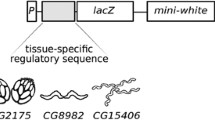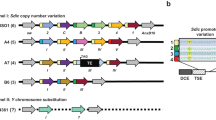Abstract
We describe the initial characterisation of a Drosophila melanogaster locus, Mst40 (Male-specific transcript), that was cloned on the basis of its malespecific transcription during the third larval instar. Corresponding low molecular weight poly(A)+ mRNAs are abundant in primary spermatocytes, but in no other larval or adult tissue. During early embryogenesis Mst40 expression is complex; initially transcription is detected during early cleavage stages. This early expression appears as two discrete dots of hybridisation associated with each nucleus. Subsequently, the transcripts are abundant in the cytoplasm of the newly formed pole cells. In the genome Mst40 sequences are located in region 40, at the base of chromosome 2L, close to, or within, the β-heterochromatin. The Mst40 sequences are organised as a tandemly arrayed 1.4 kb repeat unit. The repeat is conserved in all D. melanogaster strains examined but absent from other Drosophila species studied. The locus does not correspond to any known complementation groups in the region and has yet to be assigned a function
Similar content being viewed by others
References
Aboim AN (1945) Development embryonaire et post-embryonaire des gonades normales et agametiques de Drosophila melanogaster. Rev Suisse Zool 52:53–154
Ashburner M (1989a) Drosophila a laboratory handbook. Cold Spring Harbor Laboratory Press, New York
Ashburner M (1989b) Drosophila a laboratory manual. Cold Spring Harbor Laboratory Press, New York
Aviv H, Leder P (1972) Purification of biologically active globin mRNA by chromatography on oligothymidylic acid-cellulose. Proc Natl Acad Sci USA 69:1408–1412
Baker BS, Belote JM (1983) Sex determination and dosage compensation in Drosophila melanogaster. Annu Rev Genet 17:345–393
Bingham PM, Zachar Z (1989) Retrotransposons and the FB transposon from Drosophila melanogaster. In: Berg D, Howe M (eds) Mobile DNA. American Society for Microbiology, Washington, DC, pp 485–502
Boggs RT, Gregor P, Idriss S, Belote JM, McKeown M (1987) Regulation of sexual differentiation in Drosophila melanogaster via alternative splicing of RNA from the transformer gene. Cell 50:739–747
Bonaccorsi S, Pisano C, Puoti F, Gatti M (1988) Y chromosome loops in Drosophila melanogaster. Genetics 120:1015–1034
Boswell RE, Mahowald AP (1985) Tudor, a gene required for assembly of the germ plasm in Drosophila melanogaster. Cell 43:97–104
Brown EH, King RC (1960) Studies on the expression of the transformer gene of Drosophila melanogaster. Genetics 46:143–156
Campos-Ortega J, Hartenstein V (1985) The embryonic development of Drosophila melanogaster. Springer-Verlag, Berlin
Chomezynski P, Sacchi N (1987) Single step method of RNA isolation by acid guanidinium thiocyanate-phenol-chloroform extraction. Anal Biochem 162:156–159
Danilevskaya ON, Kurenova EV, Pavlova MN, Bebehov DV, Link AJ, Koga A, Vellek A, Hartl DL (1991) He-T family of DNA sequences in the Y-chromosome of Drosophila melanogaster share homology with the X-linked Stellate genes. Chromosoma 100:118–124
Das CC, Kaufmann BP, Gay H (1964) Autoradiographic evidence of synthesis of an arginine-rich histone during spermiogenesis in Drosophila melanogaster. Nature 204:108–109
Devereux J, Haeberel P, Smithies O (1984) A comprehensive set of sequence analysis programs for the VAX. Nucleic Acids Res 12:387–395
DiBenedetto AJ, Lakich DM, Kruger WD, Belote JM, Baker BS, Wolfner MF (1987) Sequences expressed sex-specifically in Drosophila melanogaster adults. Dev Biol 119:242–251
Dimitri P (1991) Cytogenetic analysis of the second chromosome heterochromatin of Drosophila melanogaster. Genetics 127:553–564
Edgar BA, Schubiger G (1986) Parameters controlling transcriptional activation during carly Drosophila development. Cell 44:871–877
Feinberg AP, Vogelstein B (1983) A technique for radiolabelling DNA restriction fragments to high specific activity. Anal Biochem 132:6–13
Fyrberg EA, Bond BJ, Hershey ND, Mixter KS, Davidson N (1981) The actin genes of Drosophila are highly conserved but intron positions are not. Cell 24:107–116
Ganetzky B (1977) On the components of segregation distortion in Drosophila melanogaster. Genetics 86:321–355
Goldstein LSB, Hardy RW, Lindsley DL (1982) Structural genes on the Y chromosome of Drosophila melanogaster. Proc Natl Acad Sci USA 79:7405–7409
Gonczy P, Viswanathan S, DiNardo S (1992) Probing spermatogenesis in Drosophila with P-element enhancer detectors. Development 114:89–98
Goralski T, Edstrom JE, Baker BS (1989) The sex determination locus transformer-2 of Drosophila encodes a polypeptide with similarity to RNA binding proteins. Cell 56:1011–1018
Heitz E (1934) Über α-and β-Heterochromatin sowie Konstanz und Bau der Chromomeren bei Drosophila. Biol Zentralbl 54:558–609
henikoff S (1984) Unidirectional digestion with exonuclease III creates targeted breakpoints for DNA sequencing. Gene 28:351–359
Hennig W (1985) Y chromosome function and spermatogenesis in Drosophila hydei. Adv Genet 23:179–234
Hess O, Meyer GF (1968) Genetic activities of the Y chromosome in Drosophila during spermatogenesis. Adv Genet 14:171–228
Hilliker AJ, Appels R (1980) The genetic analysis of D. melanogaster heterochromatin. Cell 21:607–619
Kuhn R, Schafer U, Schafer M, (1988) Cis-acting regions sufficient for spermatocyte-specific transcriptional and spermatid-specific translational control of the Drosophila melanogaster gene mst (3) g19. EMBO J 7:447–454
Lifschytz E (1987) The genetic control of spermatogenesis. Int Rev Cytol 109:211–258
Lindsley DL, Lifschytz E (1972) The genetic control of spermatogenesis in Drosophila. In: Beatty RA, Gluecksohn-Waelsch S (eds) Proc Int Symp, Genetic control of the spermatozoon, Edinburgh, pp 203–222
Lindsley DL, Tokuyasu KT (1980) Spermatogenesis. In: Ashburner M, Wright TRF (eds) The genetics and biology of Drosophila. Academic Press, London, pp 225–294
Lindsley DL, Zimm G (1992) The genome of Drosophila melanogaster. Academic Press, London
Livak KJ (1984) Organisation and mapping of a sequence on the Drosophila melanogaster X and Y chromosomes that is transcribed during spermatogenesis. Genetics 107:611–634
Livak KJ (1990) Detailed structure of the Drosophila melanogaster Stellate genes and their transcripts. Genetics 124:303–316
Manley JL (1988) Polyadenylation of mRNA precursors. Biochim Biophys Acta 950:1–12
Michiels F, Gasch A, Kaltschmidt B, Renkawitz-Pohl R (1989) A 146 bp promoter element directs the testis specificity of the Drosophila β2-tubulin gene. EMBO J 8:1559–1565
Michiels F, Wolk A, Renkawitz-Pohl R (1991) Further sequence requirements for male germ cell-specific expression under the control of the 14 bp promoter element (β2UE1) of the Drosophila β2-tubulin gene. Nucleic Acids Res 19:4515–4521
O'Connell P, Rosbash M (1984) Sequence, structure, and codon preference of the Drosophila ribosomal protein 49 gene. Nucleic Acids Res 12:5495–5513
O'Farrell PH, Edgar BA, Lakich D, Lehner CF (1989) Directing cell division during development. Science 246:635–640
Olivieri G, Olivieri A (1966) Autoradiographic study of nucleic acid synthesis during spermatogenesis in Drosophila melanogaster. Mutat Res 2:366–380
Pardue ML (1986) In-situ hybridisation to DNA of chromosomes and nuclei. In: Roberts DB (ed) Drosophila: A practical approach. IRL Press, Oxford, pp 111–137
Parkhurst SM, Corces VG (1987) Developmental expression of Drosophila melanogaster retrovirus-like transposable elements. EMBO J 6:419–424
Phillips RG, Roberts IJH, Ingham PW, Whittle JRS (1990) The Drosophila segment polarity gene patched is involved in a position-signalling mechanism in imaginal discs. Development 110:105–114
Rhaman R, Lindsley DL (1980) Male sterilising interactions between duplications and deficiencies for proximal X-chromosome material in Drosophila melanogaster. Genetics 90:40–64
Rubin GM (1983) Dispersed repetitive DNA's in Drosophila In: Shapiro JA (ed) Mobile genetic elements. Academic Press, New York, pp 329–361
Russell SRH (1989) Isolation of male-specific genes from Drosophila melanogaster. Ph D Thesis, Glasgow University
Sambrook J, Fritsch EF, Maniatis T (1989) Molecular cloning: a laboratory manual. Cold Spring Harbor Laboratory Press, New York
Schafer U (1986a) Genes for male-specific transcripts in Drosophila melanogaster. Mol Gen Genet 202:219–225
Schafer U (1986b) The regulation of male-specific transcripts by sex determining genes in Drosophila melanogaster. EMBO J 5:3579–3582
Shermoen AW, O'Farrell PH (1991) Progression of the cell cycle through mitosis leads to the abortion of nascent transcripts. Cell 67:303–310
Snyder MP, Kimbrell D, Hunkapiller M, Hill R, Fristrom J, Davidson N (1982) A transposable element that splits the promotor region inactivates the Drosophila cuticle protein gene. Proc Natl Acad Sci USA 79:7430–7434
Sonnenblick BP (1950) The early embryology of Drosophila melanogaster. In: Demerec M (ed) Biology of Drosophila. Wiley, New York pp 62–167
Steinman-Zwicky M, Schmidt H, Nothiger R (1989) Cell autonomous and inductive signals can determine the sex of the germline of Drosophila melanogaster by regulating sex-lethal. Cell 57:157–166
Temin RG, Ganetzky B, Powers PA, Lyttle TW Pimpinelli S, Dimitri P, Wu C-I, Hiraizumi Y (1991) Segregation distortion in Drosophila melanogaster: genetic and molecular analyses. Am Nat 137:287–331
Wakimoto BT, Hearn MG (1990) The effects of chromosome rearrangements on the expression of heterochromatic genes in chromosome-2L of Drosophila melanogaster. Genetics 125:141–154
Wu C-I, Lyttle TW, Wu M-L, Lin GF (1988) Association between a satellite DNA sequence and the Responder Of Segregation Distorter in Drosophila melanogaster. Cell 54:179–189
Author information
Authors and Affiliations
Rights and permissions
About this article
Cite this article
Russell, S.R.H., Kaiser, K. A Drosophila melanogaster chromosome 2L repeat is expressed in the male germ line. Chromosoma 103, 63–72 (1994). https://doi.org/10.1007/BF00364727
Received:
Revised:
Accepted:
Issue Date:
DOI: https://doi.org/10.1007/BF00364727




